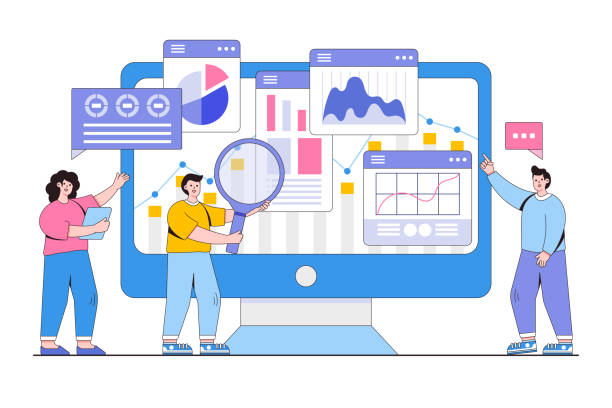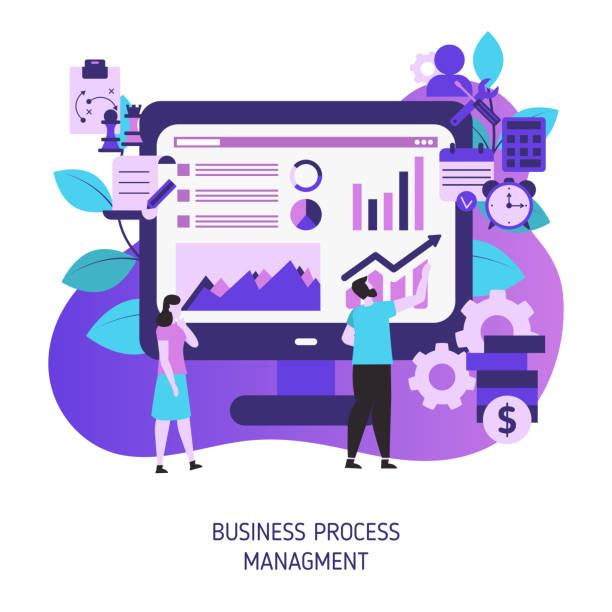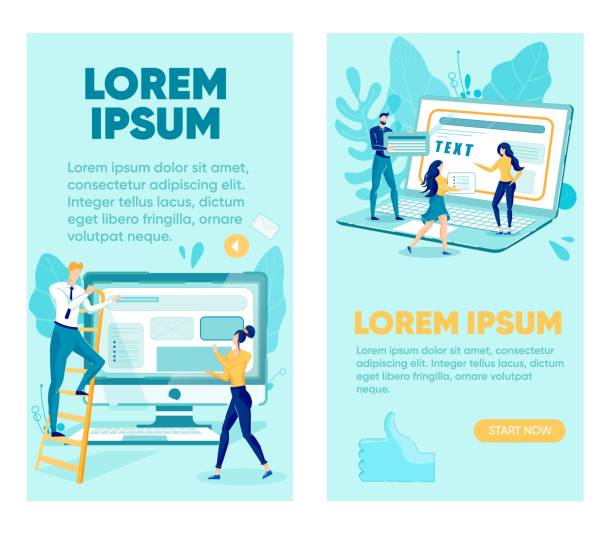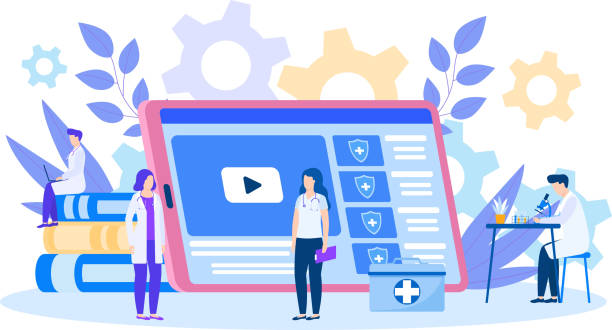Introduction to the Importance of Fast Website Design

In today’s digital world where speed is paramount, #WebsiteSpeed and #WebsitePerformance are among the most important factors for the success of any online business.
Internet users have high expectations for page load speed, and even a few seconds of delay can lead to lost visitors.
For this reason, fast website design is no longer a luxury option, but a vital necessity.
This approach not only improves user experience but also directly affects SEO (Search Engine Optimization) and the conversion rate of visitors into customers.
In this section, we #explain to you why investing in website speed is an investment in the future of your business.
Every website, from a simple personal blog to a large online store, must strive to achieve the best possible load time to succeed in the fierce competition of the online space.
This introduction is a gateway to a world where speed is considered the key to success, and we will explore practical solutions to achieve it further on.
Understanding these fundamental principles is the first step towards building a powerful and efficient digital platform.
Tired of losing business opportunities due to not having a professional corporate website? Don’t worry anymore! With Rasawab’s corporate website design services:
✅ Your brand’s credibility and professionalism will increase.
✅ You will attract more customers and sales leads.
⚡ Get a free consultation now to start!
Why Website Speed is Crucial for SEO and User Experience?

Website speed not only affects user satisfaction but is also directly linked to #SEO and #UserExperience.
Search engines like Google consider page load speed as an important ranking factor.
Slower websites may rank lower in search results, which means reduced visibility and less traffic.
For more information on search engine optimization, you can refer to this resource: SEO.
On the other hand, an excellent #UserExperience requires fast page loading.
When a user enters a website that loads immediately, they are more likely to stay on that website, view more pages, and ultimately achieve the desired goal (e.g., purchase or registration).
In contrast, a slow site quickly frustrates users and drives them towards competitors.
The Bounce Rate significantly increases, and this sends negative signals to search engines.
Fast website design means optimizing for visitors who have little time and are looking for instant access to information.
This section provides an in-depth #analytical view of the correlation between site speed, SEO, and user satisfaction, helping you understand why this factor is so vital.
Key Technical Factors in Fast Website Design

To achieve website speed optimization, familiarity with technical factors is essential.
#CodeOptimization involves minifying CSS, JavaScript, and HTML files, which reduces file sizes by removing whitespace, comments, and unnecessary code.
This allows the browser to download and interpret them faster.
#ImageOptimization is also highly important.
Large images are among the most common causes of slow websites.
Using modern formats like WebP, compressing images without significant quality loss, and implementing Lazy Loading (which loads images only when they are within the user’s viewport) can dramatically increase speed.
Database optimization, server-side and browser caching, and using Gzip compression are also other important factors.
This is the #mostTechnical part of our discussion, delving into technical details.
Proper management of fonts and external scripts can also significantly impact initial load time.
The table below provides a checklist of some of the most important technical factors for speed optimization:
| Optimization Factor | Description | Importance |
|---|---|---|
| Image Optimization | Compression and use of modern formats (e.g., WebP) | High |
| Code Compression and Minification (CSS, JS, HTML) | Removing whitespace and comments to reduce file size | Medium to High |
| Browser and Server Cache | Storing static files in the user’s browser and on the server | High |
| Database Optimization | Regular cleanup, indexing, and maintenance of the database | Medium |
| Using a Content Delivery Network (CDN) | Delivering content from the nearest server to the user | High |
The Role of Hosting and CDN in Improving Website Speed

Choosing #AppropriateHosting and using a #CDN (Content Delivery Network) are two vital factors in fast website design.
Hosting (web hosting), where your site resides, can have a profound impact on load speed.
A high-quality and fast hosting, with powerful hardware, sufficient resources, and optimized server settings, ensures that your site’s files reach users with minimal delay.
There are various types of hosting, including shared hosting, virtual private server (VPS), dedicated server, and cloud hosting, each with its own advantages and limitations in terms of speed and cost.
To learn more about the concept of hosting, you can refer to this link.
On the other hand, CDNs are networks of servers that store your website’s static content (such as images, CSS, and JavaScript) in various geographical locations.
When a user from a specific region visits your site, content is delivered to them from the nearest CDN server, which significantly reduces latency and improves load speed.
For more information about Content Delivery Networks, you can visit this link.
This section provides a #comprehensive_guide for choosing the best hosting and CDN combination to ensure your site is available to users at maximum speed and delivers an unparalleled user experience.
The right choice in this area can make a significant difference in your website’s performance.
Does your current website convert visitors into customers or scare them away? Solve this problem forever with professional corporate website design by Rasawab!
✅ Build credibility and powerful branding
✅ Attract target customers and increase sales
⚡ Get a free consultation now!
Using Optimized CMS and Frameworks for Speed

Choosing the right Content Management System (CMS) or framework plays a vital role in #SpeedingUpTheSite.
Some CMSs and frameworks are designed by default for high performance and optimized speed.
For example, #WordPress, with its extensive ecosystem of speed optimization plugins, is one of the most popular choices.
Caching plugins like WP Super Cache or LiteSpeed Cache can dramatically reduce page load times.
Furthermore, optimized themes and standard coding in WordPress enable fast website design.
Frameworks like Laravel or Rails also allow developers to build very fast websites by providing powerful tools for database optimization and cache management.
The important thing is that even with the best tools, if coding and configuration are not done correctly, site speed will be compromised.
Using optimized images, removing unnecessary plugins, and regularly updating the CMS core and plugins are among the actions that should be considered.
This section is a practical #tutorial that shows you how to make the most of the inherent capabilities of CMSs and frameworks to improve your site’s speed.
Smart choice and proper maintenance are key to achieving high performance and long-term stability.
Responsive Design and Speed on Mobile Devices

With the increasing number of mobile users, the #MobileFriendly aspect of a website and its speed on smart devices are of high importance.
#MobileSpeed not only affects user experience but Google also penalizes websites that are not optimized for mobile.
Fast website design on mobile means providing fast and optimized content for mobile networks, which usually have slower speeds compared to fixed internet.
There are specific challenges in this area, including small screen sizes, bandwidth limitations, and the need for faster loading.
Solutions such as using Responsive Design, which adapts the website to screen size, optimizing images and videos for mobile, and using Accelerated Mobile Pages (AMP) formats can help improve speed.
Paying attention to Google’s Core Web Vitals, which include metrics like Largest Contentful Paint (LCP) and Cumulative Layout Shift (CLS), is crucial for ensuring a smooth user experience on mobile.
This section of the article provides important #news about the latest mobile optimization trends and methods you can use to ensure your site performs excellently on any device.
Ensuring speed on mobile means preserving traffic and revenue in today’s world.
Website Speed Measurement and Improvement Tools

To #SpeedUpTheSite and ensure optimal performance, using #WebsiteSpeedTools is essential.
These tools help you identify your website’s weaknesses and find appropriate solutions to improve them.
Three popular and powerful tools in this area are: Google PageSpeed Insights, GTmetrix, and Pingdom Tools.
Google PageSpeed Insights, provided directly by Google, evaluates your site’s performance score for desktop and mobile and offers specific suggestions for improvement.
This tool is particularly useful for SEO purposes and Core Web Vitals.
GTmetrix provides more comprehensive reports with deeper technical details, including a Waterfall chart that shows the loading order of resources.
This tool is highly practical for developers and technical experts.
Pingdom Tools is also a fast and user-friendly tool for testing speed from different parts of the world, allowing you to examine site performance from a global user perspective.
Each of these tools has its strengths and weaknesses, and using them in combination can give you a more comprehensive view.
This #analytical and #specialized section introduces you to how to use these tools so you can continuously monitor and improve the performance of your fast website design.
The table below provides a comparison between these tools:
| Tool | Key Features | Strengths | Weaknesses |
|---|---|---|---|
| Google PageSpeed Insights | Scoring based on Core Web Vitals, Google’s suggestions | Integration with Google’s algorithms, free | Less technical detail compared to other tools |
| GTmetrix | Comprehensive reports, Waterfall analysis, recommended optimizations | Accurate and technical reports, history tracking capability | More complexity for novice users |
| Pingdom Tools | Speed checks from various geographical locations, simple user interface | Fast testing, page size display | Sometimes general suggestions lacking deep technical details |
Common Mistakes in Fast Website Design and Ways to Avoid Them

On the path to fast website design, there are some #CommonMistakes that can render your efforts ineffective.
One of the most common mistakes is loading high-volume images without optimization.
Many web designers forget that high-quality images, without proper compression or the use of optimized formats (like WebP), can severely reduce site speed.
Another mistake is the excessive use of unnecessary plugins and scripts, especially in CMSs like WordPress.
Every plugin adds extra code to the site, which can increase load time.
Ignoring server-side and browser caching is also a big mistake; it causes all content to be loaded from scratch every time a user visits the site.
Choosing inappropriate and cheap hosting can also lead to slow server speed and consequently, a slow website.
Furthermore, lack of database optimization and not using Gzip compression for files are also factors that reduce speed.
This section is a #guide and #ThoughtProvokingContent that familiarizes you with these mistakes and teaches you how to prevent them and maintain a perpetually fast and efficient website through #ContinuousOptimization and proper maintenance.
Prevention is better than cure, especially in the realm of website speed.
Are you dissatisfied with the low sales of your online store?
Rasawab is your solution for having a professional and high-selling online store.
✅ Significant increase in sales and revenue
✅ Easy and pleasant shopping experience for customers
⚡ Get a free consultation from Rasawab now!
Impact of Fast Website Design on Revenue and Branding

Website speed, beyond a technical metric, directly impacts your business’s #ROI (Return on Investment) and #Branding.
A fast website design provides a more positive user experience, leading to increased customer satisfaction.
Satisfied customers are more likely to return to your website, purchase more products or services, and even recommend your brand to others.
Research has shown that every second of delay in page loading can lead to a significant decrease in conversion rates; for example, an e-commerce site with faster loading can see a dramatic increase in its sales and revenues.
This increase in conversion rate directly translates to increased revenue and profitability.
From a branding perspective, high site speed signifies professionalism and attention to detail.
A fast website creates a positive image of your brand in users’ minds and shows that you care about their experience.
This helps reinforce your brand’s credibility and customer trust.
Conversely, a slow website can harm brand reputation, portraying it as unprofessional or inattentive to customers.
This section provides a #comprehensive_analysis of the financial and strategic impacts of site speed on your business, demonstrating why investing in speed is a smart investment that can lead to sustainable and long-term growth.
Future Trends in Website Speed Optimization

The world of fast website design is constantly evolving, with new trends emerging to improve website speed and performance.
One of the most important #FutureTrends is an increased focus on Google’s Core Web Vitals, which include metrics like LCP (Largest Contentful Paint), FID (First Input Delay), and CLS (Cumulative Layout Shift).
These metrics are evaluated based on the user’s actual experience of load speed, interactivity, and visual stability, and their importance in Google’s ranking is increasing.
New technologies such as Edge Computing (processing at the network edge), which processes data closer to the user, and the use of Artificial Intelligence in website optimization are under development.
AI can suggest the best solutions for caching, compression, and resource loading by analyzing user behavior and performance data.
Also, advancements in network protocols like HTTP/3 and more advanced technologies like Service Workers for improving offline capabilities and faster loading promise a faster future for the web.
This section is an exciting and #entertaining_news that gives you a glimpse into the future of website speed optimization.
By following these trends and keeping your knowledge and tools up-to-date, you can ensure that your website is always at the forefront of technology and provides the best possible experience to users.
The future of web speed is bright and full of innovation.
Frequently Asked Questions
| Question | Answer |
|---|---|
| What is fast website design? | A process for building a website that loads quickly and provides a smooth and optimized user experience. |
| Why is website speed important? | Increased user satisfaction, improved search engine rankings (SEO), reduced bounce rate, and increased conversion rate. |
| What factors affect website speed? | Page size, number of HTTP requests, image optimization, JavaScript and CSS codes, server speed, and caching. |
| How can website speed be measured? | Using tools like Google PageSpeed Insights, GTmetrix, Pingdom Tools. |
| How can website speed be increased? | Image optimization, file compression (CSS, JS, HTML), browser caching, reducing redirects, choosing suitable hosting. |
| Does fast website design mean low quality? | No, fast design means designing with a focus on speed and efficiency optimization, not reducing design or content quality. |
| What is the role of hosting in website speed? | The speed and quality of the hosting server directly impact the site’s response time and thus the loading speed. |
| How can images be optimized for speed? | Using appropriate formats (like WebP), compressing images without significant quality loss, specifying clear dimensions for images. |
| Can complex websites also be fast? | Yes, by using appropriate architecture, code optimization, and resource management, even complex websites can have high speed. |
| Is fast website design the same as Agile development? | No, fast website design focuses on the final outcome (a fast website), whereas Agile development is a methodology for project management and software development. |
And other advertising services of Rasawab Advertising Agency
Investigating the Impact of Combination Sales in Pet Product Manufacturers’ Ads
Increasing Credibility by Providing Valid Documents in Manufacturers’ Ads
The Role of Special Ads in Attracting Luxury Customers to Pet Products
Reviewing Effective Communication Methods in Manufacturers’ Ads
Utilizing Multimedia Features in Manufacturers’ Ads
And hundreds of other services in the field of internet advertising, advertising consultation, and organizational solutions
Internet Advertising | Advertising Strategy | Advertorial
🎯 To achieve your major business goals in the digital world, Rasawab Afarin Digital Marketing Agency is by your side with a professional and results-oriented approach. From personal website design to comprehensive SEO and content marketing strategies, we provide everything you need to be seen and grow.
📍 Tehran, Mirdamad Street, next to Bank Markazi, Southern Kazeroun Alley, Ramin Alley, No. 6

